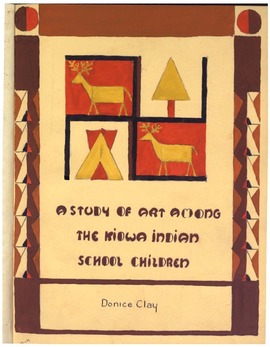| dc.description.abstract | It is the purpose of this study to analyze the charaoteristics of Kiowa Indian Art as evidenced in the work of the school children in order to draw certain conclusions that would prove beneficial to us in our individual interpretation of the art principles. I feel that I have become greatly enriched from my contact with the Indian school children. It was a never ceasing inspiration to watch them overcome their hesitancy and reticence in their enthusiasm and love of creation. In the preparation of this study several methods of procedures were employed. The work of the Kiowa Indian children was collected and studied. In order to obtain the best results, they were not informed for hat purpose the work was done, nor were they given definite assignments. From the first they selected their own subject matter, color combinations, and materiaIs with which to work. Different types of materials were provided for them, among which were crayolas, water colors, colored chalk, colored ink, colored pencils, construction paper, and drawing tablets. In working with color combinations the children were allowed to choose the colored paper that they liked best. They not only drew upon their imagination for combining colors but represented them as they had actually been used among the tribe. As they loved to draw, all that was necessary as the permission to stay after school if they wished "and color." So great was their love of this work that often they remained through the entire noon period, not wishing to take the time to eat. It has been from this procedure that the major part of the information set forth has been obtained. The second method was the collecting of data concerning their history as it would affect their art. This was accomplished through books, visits to the Indians themselves and information from the white people who had lived among them for research work. Kodak pictures were taken of the children in their ceremonial costumes, and collected from other sources from which reproductions were made. Pictures of relics were received from friends. When impossible to seoure the original pictures, tracings were used. In working on the designs, beadwork was collected a much as possible, otherwise pictures were traced from older sources. In the title page a style of lettering as designed by Enosta Maunkee, Mildred Mausape, and Aileen Redbird. The motifs used are taken from designs of the Kiowa tribe worked out by the school children and rearranged by the writer to make an artistic and appropriate d sign for this page. The work is based upon three types; past and present craftwork, work of the older youths of the tribe, and that of the Kiowa Indian school children. By these three types it is possible to trace the tribal characteristics plainly and see here the white people may learn methods of technique, color combinations, and design. | |
